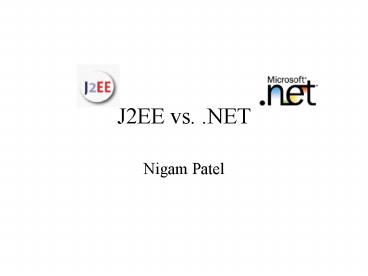J2EE vs. .NET - PowerPoint PPT Presentation
1 / 19
Title: J2EE vs. .NET
1
J2EE vs. .NET
- Nigam Patel
2
Topics
- Background
- Web Services, J2EE and .NET
- Similarities
- Differences
- Conclusion
- Pros and Con (J2EE and .NET)
3
Web Services
- What is Web Services?
- Helps applications to be integrated
- Foundation of web services is XML messaging over
standard web protocol such as HTTP - Can integrate two businesses, departments, or
applications quickly and cost-effectively.
4
Web Services
Cont..
Client
SOAP
WS
5
J2EE
- J2EE architecture is defined by the Sun
standards. - Architecture is based on the Java programming
language. - Good thing about Java is that it enables the
organization to write code once and deploy that
code onto any platform.
6
J2EE
Cont...
- Partial J2EE components list
- JavaServer Pages (JSPs)
- Servlets
- Enterprise JavaBeans (EJBs)
- Java Connectivity Architecture (JCA)
- Java Message Service (JMS)
- Java Management Extensions (JMX)
- Java Naming and Directory Interface (JNDI)
7
J2EE
Cont...
Servlets, Java Server Pages
Presentation Layer
EJB, Java Language
Business Layer
Data Layer
JDBC compatible DB
8
.NET
- .NET is Microsoft Product
- Framework of Microsoft .NET offers language
independence
9
.NET
Cont...
C
CLR
MSIL
Compiler
VB .NET
First source code is translated into Microsoft
Intermediate Language (MSIL or IL). This MSIL is
language-neutral, same as Java bytecode. Then
MSIL code needs to be interpreted and translated
into a native executable. The .NET Framework
includes the Common Language Runtime (CLR), same
as the Java Runtime Environment (JRE), which
achieves the goal.
10
.NET
Cont...
ASP .NET
Presentation Layer
COM, Visual Studio .NET
Business Layer
Data Layer
SQL Server
11
Similarities J2EE .NET
By comparing Big Picture of .NET and J2EE we can
Technology similarities
12
Differences J2EE .NET
- Presentation Layer
In J2EE, JSPs and servlets generate HTML. The
servlet includes features like session state,
security framework and configuration. In .NET,
ASP.NET generates HTML. ASP.NET builds and hosts
Web application under Microsofts Internet
Information Server (IIS). ASP .NET includes
stuff like session state, authentication and
authorization. With ASP .NET, developer build
HTML and custom tags that map to server-side web
controls.
13
Differences J2EE .NET
Cont...
- Business Layer
- Transaction Processing
- Calling Remote Objects
- XML web services
- Data Access Layer
- J2EE has two types CMP BMP
- .NET ADO.NET classes
14
Differences J2EE .NET
Cont...
- Platform Comparison
- Cross-platform portability
- Language support
- Tools Support
- Vendor suppor
15
J2EE (PROS)
- Runs on any operating system and application
server (may need adjustments) - Handles complex, high- volume, high-transaction
applications - Has more enterprise features for session
management, fail-over, load balancing and
application integration - Is favored by experienced enterprise vendors such
as IBM, BEA, SAP and Oracle - Offers a wide range of vendor choices for tools
and application servers
16
J2EE (CONS)
- Has a complex application development environment
- Tools can be difficult to use
- Java Swing environment's ability to build
graphical user interfaces has limitations - May cost more to build, deploy and manage
applications - Is difficult to use for quick-turnaround,
low-cost and mass-market projects
17
.NET (PROS)
- Easy-to-use tools may increase programmer
productivity - Has a strong framework for building rich
graphical user interfaces - Is tightly integrated with Microsoft's operating
system and enterprise server software - May cost less, due in part to built-in
application server in Windows, unified
management, less expensive tools
18
.NET (CONS)
- Framework runs only on Windows, restricting
vendor choice - Users of prior Microsoft tools and technology
face a potentially steep learning curve - Questions persist about the scalability and
transaction capability of the Windows platform - Choice of integrated development environments is
limited - Getting older applications to run in new .Net
environment may require effort
19
Questions ?????































